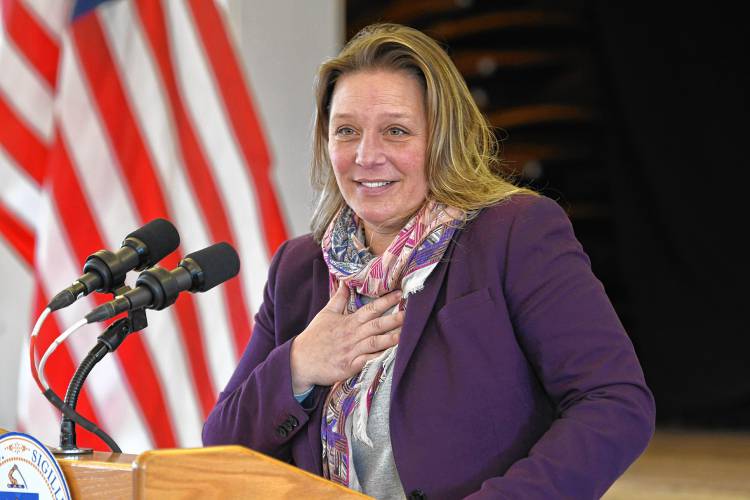Increased rural school aid ‘a tremendous win,’ administrators and legislators say
| Published: 08-18-2023 6:35 PM |
Months after Gov. Maura Healey’s initial budget proposal showed a moderate increase to rural school aid, that line item has nearly tripled in the approved budget, in what area administrators say is a step in the right direction toward equitable education in rural districts.
Signed earlier this month by Healey, the final fiscal year 2024 budget includes hundreds of millions of dollars for education across the state, including increases of $9.5 million for rural school aid and $21.3 million for regional school transportation reimbursements. Other general increases to education include full funding of the Student Opportunity Act, increased Chapter 70 aid and early education grants, among others.
With those increases, the rural school aid line item now stands at $15 million — or an approximately 172% increase over fiscal year 2023’s $5.5 million appropriation — which local officials say is a good start toward reaching the Special Commission on Rural School Districts’ $60 million recommendation to offset increasing costs in the face of declining enrollment and lack of economic resources in rural areas.
“Our initial reaction is certainly gratitude,” said Mohawk Trail and Hawlemont regional school districts Superintendent Sheryl Stanton. “We’re excited there’s actually been movement in the budget process that acknowledges this is a more complex problem than, ‘Why don’t you regionalize or reduce costs?’”
In Northfield, Pioneer Valley Regional School District Director of Finance and Operations Jordan Burns said the increased funding is a potential opportunity to take some pressure off the districts’ member towns and add more professional development days to invest in the schools’ teaching staffs.
“We are pleasantly surprised. Throughout the budget planning process going from the House to the Senate, we saw the possibility for some of the increases, but you never want to count on it until it’s signed by the governor,” Burns said. “We’ve already started on the work of discussing what we’re going to do with this pleasant surprise.”
While welcome, Stanton added more aid is needed to ensure districts are able to provide an education on par with those in larger, wealthier communities in the eastern part of the state.
Echoing that sentiment is Huntington’s Gateway Regional School District Superintendent Kristen Smidy, who said the increased aid is “definitely a step in the right direction, but there’s still a lot of unknowns” when it comes to what districts will be eligible for the increased funding and how much they’ll receive.
Article continues after...
Yesterday's Most Read Articles
 Serious barn fire averted due to quick response in Shelburne
Serious barn fire averted due to quick response in Shelburne
 Bridge of Flowers in Shelburne Falls to open on plant sale day, May 11
Bridge of Flowers in Shelburne Falls to open on plant sale day, May 11
 Political newcomer defeats Shores Ness for Deerfield Selectboard seat
Political newcomer defeats Shores Ness for Deerfield Selectboard seat
 Roundup: Pioneer baseball wins Suburban League West title following 2-0 win over Hopkins
Roundup: Pioneer baseball wins Suburban League West title following 2-0 win over Hopkins
 As I See It: Between Israel and Palestine: Which side should we be on, and why?
As I See It: Between Israel and Palestine: Which side should we be on, and why?
 Employee pay, real estate top Erving Town Meeting warrant
Employee pay, real estate top Erving Town Meeting warrant
“It concerns me that it’s not clear what communities are going to be receiving aid,” Smidy said. “Communities have qualified in and out over time.”
The Department of Elementary and Secondary Education typically distributes these payments in October, which is far past when districts approve their budgets in early March. Districts are eligible if student density is less than 35 students per square mile and if their per capita income is not more than the average per capita income for the state.
In fiscal year 2023, Mohawk Trail received $262,000, Gateway received nearly $301,000 and Pioneer received $175,000 in rural aid funding. The challenge, Stanton, Smidy and Burns all said, is rural aid is individually appropriated each year and, while it has increased over the last three fiscal years, there’s no guarantee it will continue to increase — or that it will be appropriated at all.
“We can use rural aid for sure … but it’s irresponsible to rely on and hope for rural aid considering it’s not guaranteed every year,” Smidy said, adding that Gateway typically uses its aid for things like staffing, “essential programming” and safety upgrades. “I’m hoping this is good progress for bringing attention to the need of equity.”
“If recent history tells us anything, it’s probably going to continue to grow, but we want to be conscientious,” Burns added.
One solution, the administrators said, would be enshrining this type of aid into law, which would at least provide schools with a known quantity they can rely on each year.
Stanton emphasized the importance of rural aid for districts like hers, in which the money is used to support the schools and their students.
“Rural aid isn’t about add-ons, it isn’t about getting band uniforms and the extras we can’t get to,” Stanton said. “What rural aid is about is high-quality education for kids that is equitable to our eastern, suburban and urban districts.”
State Rep. Natalie Blais, D-Deerfield, who co-chaired the Special Commission on Rural School Districts, said the increase is a huge step forward for funding rural schools. Additionally, she said she is seeing growing support for bills H.3567 and S.2388, which would enact several of the recommendations in the special commission’s 2022 report. State Sen. Jo Comerford, D-Northampton, filed the Senate version of the bill.
“A $9.5 million increase for rural school aid is a tremendous win and is the direct result of the advocacy of stakeholders across the commonwealth,” Blais said. “There’s still much work to be done and I am heartened by the growing coalition that is pushing for the recommendations that were included in the Rural Schools report and omnibus bill I filed with Sen. Comerford.”
Chris Larabee can be reached at clarabee@recorder.com or 413-930-4081.



 New Salem election ushers in new Selectboard member
New Salem election ushers in new Selectboard member Community Legal Aid expands Disability Benefits Project to Franklin County
Community Legal Aid expands Disability Benefits Project to Franklin County
